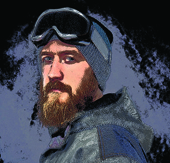

 |
 |
 |
 |
 |
  |
DAY 2 - IT ALL STARTS AT SCHOEMANSDAL
After an early-morning breakfast, the group make their way up the mountain. The route starts at the historical mess hall at Schoemansdal - a place where thousands of young children had been fed since the veldskool officially started in the 1970s.
During breakfast, Marelize tried to find out when the first young “adventurers” had woken up in these buildings, but no-one seemed to be sure – not even Edwin Buys, their guide, who seemed a veritable fount of information about the school and the surrounding areas. He told her that one of the region’s first schools, the Happy Rest farm school, was started there in 1912. “For the next 40 years, it was a typical farm school, but in the mid-1950s it was turned into a centre for children with special needs,” said Edwin, looking pleased to impart this titbit.
The idea that children should be sent far away from home to get an education somehow appalled Marelize. What would “special needs” really mean? Was it simply a dumping ground for delinquent children?
“In the 1960s, it became a ‘Children’s-Act School’,” said Edwin, making quotation marks with his fingers in the air. “A term some high-brass planners of the education department dreamed up to refer to a centre where they sent children when their parents couldn’t care for them anymore. But these schools were also for outcasts - children who had behavioural problems and couldn’t fit in at regular schools.” For a moment he looked a bit guilty, ashamed, as if he might have been one of them.
“Then, for a year or two, around 1974, the school catered for children with disabilities. Shame, this didn’t work out so nicely,” said Edwin, his eyes becoming a bit watery, “but then some bigshot got the idea to turn it into a veldskool, you know, a place where groups of children could learn more about nature and conservation. So, for almost 50 years, Schoemansdal became a place of adventure, where young people made friends and beautiful memories.” Edwin definitely looked positively emotional!
Like thousands of children throughout the years, Marelize and the other 10 adventurers made their way up the mountain, following Edwin. They opted for the difficult, but much more picturesque, route that followed the stream and kept them in the shade of the ancient trees. The route took them through the gorge, and every now and then they had to cross the stream of sparkling fountain water.
After about two hours of climbing, the route upward became very steep, and they had to use a rope ladder to scale some cliffs. Marelize and Liza were the two people least comfortable with the rock climbing, but they were more afraid of being left behind, so they pushed through.
When they broke for an early lunch while still in the indigenous forest, Marelize was only too glad to rid herself of the heavy backpack and sat down next to the massive root of a fever tree. The root had some distinctive marks, which almost looked as if someone had scratched it with a file or a knife.
“Those are leopard scratches,” said Gerrit. “But don’t worry, you won’t encounter them.”
“Yes, they will see you, but the chances of you seeing them are slim,” added Edwin.
That wasn’t very reassuring to Marelize, but the almost lackadaisical approach of both Gerrit and Edwin eased her mind a bit.
The route for the remainder of the day would hopefully be less strenuous. They had some more climbing to do, but then the way eased out when they reached the upper Schoemansdal campsite. They were to turn west, with a short stretch of sandy road waiting before they reached Crewe, where they would spend the night.
But for now, the time had come for lunch and the next “scars” adventure. Rovha was next in line, and he promised them a much more exciting story than Marelize’s.
Click here to read Rovha's (demo) story
DAY 2 - A QUAINT LITTLE CHAPEL WITH A LOT OF HISTORY
It was with more than a bit of reluctance that the group finished their lunch next to the stream and headed further up the mountain. The route took them along the gorge with its majestic indigenous trees. Gradually, the trees became less dense, with more mopane veld appearing.
Once they reached the top, the landscape started changing. The trail became sandy, making maintaining a steady pace more difficult.
After a quick stop at the upper Schoemansdal campsite, their guide, Edwin, led them to the west of the mountain. They had now linked up with what is commonly known as the Bluegumspoort road. This picturesque route starts at the N1, some 10 kilometres north of Louis Trichardt, and winds its way westward through beautiful farms, cottages and even a few fishing dams.
Fortunately for them, from the Schoemansdal campsite they didn’t have too far to go. “There is the Crewe farm,” Edwin pointed out. On the right-hand side of the road a quaint little church was visible.
The group ignored the building at first, being more interested in offloading their backpacks at the farmhouse and sorting out their sleeping quarters. “We will meet at the boma at five,” Edwin said before making his way to his own room.
Marelize’s curiosity quickly got the upper hand. She loved historic places and wanted to find out more about the little church. A Lutheran chapel, if she wasn’t mistaken. She made her way there and, for the first few minutes, she could do nothing more than just stand and look at the building. She felt as if thousands of memories, dreams and probably doubts were trapped in the bricks of this holy building. How many couples had promised eternal love to their partners in this chapel? How many funeral services might have taken place here?
She noticed an inscription, simply saying: “Zum andenken an Robert Franz und Martin Jäckel.” Who would the Franz and Jäckel families have been, she wondered?
“The chapel was built in 1978 by the Jäckel family,” said Edwin, who had also made his way across to the church. “The little chapel is also symbolic of a long line of Swiss missionaries in the Soutpansberg.”
When he saw Marelize’s look of interest, Edwin started talking about this history, which dated to 1869 when two Swiss missionaries, Ernest Creux and Paul Berthoud, arrived in South Africa. They had made their way north and, in 1875, started a missionary station at Valdezia, catering predominantly for the Tsonga people.
“But the Franz and Jäckel families are best remembered for their involvement at Blouberg,” Edwin remarked, pointing vaguely. Marelize at least knew that the Blouberg he was referring to was a mountain not far away. When they finished their route in a few days’ time, they should be able to see Blouberg in the distance, towards Polokwane.
“Rev Robert Franz and his wife, Helene, arrived at the Blauberg missionary station around 1896. Mrs Franz was a passionate nurse and, shortly after the Anglo-Boer War, she established a hospital for lepers.” Edwin gave a little shudder, as if the idea of leprosy made him queasy. “She was later joined by her sister, Johanna Schulz, a qualified nursing sister from Prussia, who was to spend the greater part of her life at the hospital.
“What started off as a labour of love, quickly grew too big and they needed government support. When a hospital was built at Bochum, some 30 kilometres away, Helene Franz was asked to manage that. The Franz family moved to Bochum in 1908,” said Edwin, tilting his head and nodding.
Marelize wondered how he remembered all these facts and dates. He must really be into this guide thing…
“In 1914, Rev Martin Jäckel was sent as a replacement for Rev Franz to the Blauberg Missionary Station. He married one of the Franz daughters, also called Helen, in 1920. The Jäckel family bought the Crewe farm in the mountain in 1954. Martin Jäckel died in 1959 and was buried on the farm. When the little church was built in 1978, it was named after him,” said Edwin, a distant look on his face, as if making sure that he had recalled all the facts correctly.
For some time, Edwin and Marelize stood in silence next to the chapel. “The church’s bell has an inscription that says ‘Und Glocken hör ich weit’. This is also the title of the book that Rev Jäckel wrote about his experiences here,” said Edwin.
“I suppose we should now return to the group,” remarked Marelize, turning away and starting to walk. “Apparently Gerard will tell us more about his scar tonight. Somehow, I think his story will be interesting…”
Click here to read Gerard's story
Meet the adventurers:
 |
Our narratorMarelize (27) is the narrator of the story. She is a seasoned traveller and has visited countries in Europe and the USA. |
|
Rovha is a soft-spoken dentist with smiling eyes. He is a loner and can often be found in a quiet corner reading a book or newspaper. |
 |
 |
Gerard is a Dutch adventure tourist. At 66 he has retired from the university he has been teaching at. He now spends his time travelling. |
|
Zachary (39) is a geologist. His insatiable thirst for adventure has taken him on many dangerous trails and earned him the title of Bear Grylls. |
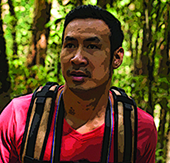 |
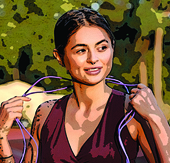 |
Lee (28) has never let her neurological disorder become a disablity. Although physically strong, she has a emotional scar she hides well. |
|
Emma is a 37-year-old award-winning journalist who is currently working for a local newspaper but aspires to be a war photographer. |
 |
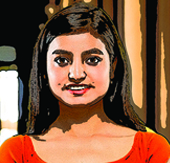 |
Shabnim's small stature may be deceiving but at age 42, she is a tough adventurer and a well-respected lecturer at a local university. |
|
Adrian is a boisterous character who enjoys controlling the conversation. He usually leads the pack and shares his expertise freely. |
|
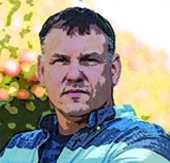 |
With a military background, Gerrit (55) was a captain in the old South African Army. He has seen the horrors of war and still runs from it. |
|
For the vibrant and energetic 25-year-old Takalani (Taki) nursing has always been |
 |
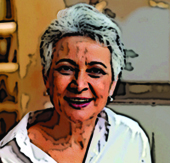 |
Lisa (53) is the mother of two grown daughters and the wife of a wealthy CEO who travels a lot. Lisa has taken up hiking to fill her days. |






